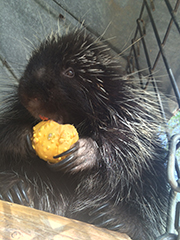August 9, 2017
Prickly situation: K-State veterinarians, specialists treat porcupine with potentially zoonotic skin infection

The latest issue of the Journal of Zoo and Wildlife Medicine details how a fungal skin infection in a porcupine at Manhattan's Sunset Zoo was carefully diagnosed and successfully treated with the help of veterinary specialists at Kansas State University's College of Veterinary Medicine.
Christine Hackworth, a veterinary technician at the College of Veterinary Medicine, is the lead author of "Diagnosis and Successful Treatment of a Potentially Zoonotic Dermatophytosis Caused by Microsporum Gypseum in a Zoo-housed North American Porcupine (Erethizon Dorsatum)."
Hackworth wrote up the diagnosis and treatment of a zoo-kept porcupine with a skin condition that was potentially zoonotic, meaning it can be transmitted to humans. In this case, the porcupine was diagnosed with Microsporum gypseum dermatophytosis, more commonly associated with household pets and referred to as ringworm.
"Sydney the porcupine was presented to us from the Sunset Zoo showing signs of unilateral pedal crusting and alopecic dermatopathy," said Hackworth, who works in the zoological medicine and dermatology sections of the Veterinary Health Center. "Testing revealed a fungal infection called M. gypseum. From what we understand, this is the first report of M. gypseum diagnosed and treated in a captive North American porcupine, so zookeepers and veterinary staff should be aware of this potentially zoonotic infection."
"Kansas State University and Sunset Zoo have had a long and excellent relationship," said Scott Shoemaker, zoo director. "K-State veterinarians provide first class care for the animals in the zoo's collection."
For the first nine days, the porcupine was administered topical treatments of miconazole, an antifungal medication. This was followed by oral doses of a second antifungal medicated called terbinafine.
"About four weeks after the initial examination, Sydney's clinical signs were definitely improving, and fungal cultures of the front foot, muzzle and noninfected area along the dorsum were negative for any indication of M. gypseum," Hackworth said.
Examinations of the porcupine were conducted regularly after these treatments. More than 80 days after the initial evaluation, Hackworth said the clinical signs had completely resolved and repeat fungal cultures were negative.
The journal article was co-authored by David Eshar, Mary Bagladi-Swanson, Gordon A. Andrews and James W. Carpenter, faculty members at K-State, and Melissa Nau, a former clinical intern at the Veterinary Health Center.
"In this porcupine case, Christine was able to combine her clinical skills from her work in the dermatology service and the zoological medicine service," said Eshar, assistant professor in companion exotic pets, wildlife and zoo animal medicine. "We are very fortunate to have her as part of the team. It is not easy to make the efforts to write a clinical report, but Christine's drive to educate others goes beyond the limits of the veterinary college. All veterinarians working with all species are also in the front line to alert the public on diseases that can potentially also harm people, and those working with zoo-kept animals are no exception to that."
